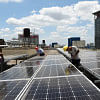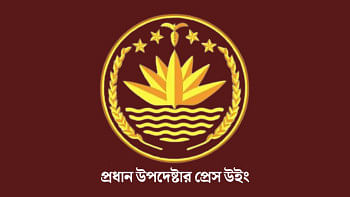Beyond renewables: A coordinated and just transition for Bangladesh

Bangladesh is lagging behind its renewable energy targets, with the current capacity standing at just four percent relative to the target of 10 percent by 2020, making it unlikely to reach the target of 100 percent by 2050. Yet, the success of the latest Conference of the Parties (COP28) agreement to substantially increase renewables in the next decade relies heavily on Asia, where many countries like Bangladesh are struggling to keep up.
Conversations and debates are plentiful around energy sources: renewables versus fossil fuel, and the challenges with renewables like high land requirements for solar expansion. However, what it takes for developing countries like Bangladesh to achieve a green transition gets limited attention.
So what are the crucial aspects of successful renewable energy transition that must be considered for a country like Bangladesh?
Transmission and distribution
The Bangladesh government has built many power plants in recent years, but without corresponding investments to enhance the efficiency and functionality of the transmission and distribution systems. Without simultaneous, stepwise improvements in transmission, we risk a capacity logjam by only increasing production capacity, be it in renewables or fossil fuel. Regular planned power outages (load-shedding) while the existing power plants operate below capacity indicate an inadequate transmission system. However, another important cause of below-capacity production is the rising costs of importing coal, gas, and oil amid the growing foreign exchange reserve crisis. This further emphasises the need for diversifying domestic energy sources into renewables, especially because the country's existing gas reserve is dwindling and new exploration is not yet on the horizon.
However, to accommodate the intermittency of renewables—such as the seasonality of hydropower and surge during noon for solar power—the transmission and distribution system must be updated. Moreover, our ambitious 2050 goal is only possible with trade within the region, which also requires expanding the transmission system. Nepal and Bhutan have surplus energy from hydropower during the monsoon season, and India has swathes of arid land with low cloud cover, raising the potential of renewable energy trade with Bangladesh, where the topology, population, and agricultural density limit the renewable production possibility. Indeed, the recent tripartite power-sharing agreement between Bangladesh, Nepal, and India is a step in that direction. But ramping up regional trade may require dedicated transmission lines and grid integration. These technical challenges can be answered with tried and tested solutions elsewhere. However, these require investment and coordinated development across the board, in line with capacity increases and demand mapping for the medium and long run as our industrial energy requirements are expected to continue changing.
Such investments in the transmission and distribution system have the added benefit of increasing efficiency and thereby minimising system loss and the associated carbon emissions from power use. The upgrading of grid systems needs to support rooftop solar and net metering options for both households and industrial rooftops, including in economic zones. Lowering high duties on inverters and greater availability of bi-directional metres could incentivise the adoption of rooftop solar by allowing sell-back to the grid. But most importantly, the grid needs to be upgraded to support such an initiative.
Sources and costs of financing
Infrastructure projects in developing and emerging economies often cannot attract sufficient financing. Challenges of scaling up investments include the high cost of funds in developing countries like Bangladesh, partly due to the lack of a deep domestic financing market. The constraint may be partially addressed by using a combination of sources at different stages of the project—public financing from governments and banks acting as debt investors in the early stage, and bond financing at a later stage.
As we become a developing country, it would be beneficial to continue to have concessional rates for sectors like renewables and transmission. Multilateral development institutions are well-placed to provide long-term financing for projects that have public benefits. With the proliferation of Southern-led development banks like the Asian Infrastructure Investment Bank (AIIB), New Development Bank (NDB), and the Islamic Development Bank (IsDB), in addition to the traditional Bretton Woods Institutions (BWIs) like the World Bank and Asian Development Bank (ADB), different types of support for large infrastructure projects at different stages are possible.
Older multilaterals and the newer Southern-led multilateral development banks are increasingly financing different kinds of projects. BWIs are financing preparatory work, feasibility studies, and capacity-building compared to earlier greenfield power projects. Instead, large-scale power projects are now funded through bilateral financing and the newer Southern-led policy banks. This difference between older and newer multilaterals in their respective specialisations could help address challenges around inadequate preparation and due diligence of projects that countries like Bangladesh face when seeking financing, which contributes to the higher cost of financing. The prioritisation of older BWIs on capacity-building could help Bangladesh do the necessary leg work required to seek financing for bankable projects from Southern development banks and other bilateral sources.

In addition to sources of financing, the costs of financing must be made more salient and central to our policy conversations. The financing terms, including interest rates and repayment timelines, are often not made obvious to the taxpayers. Increasing production capacity without simultaneously improving transmission and distribution systems will mean unused power plants that are not operating, while loan repayments for their construction keep racking up. Finally, infrastructure financing in Bangladesh relies on policy support such as subsidies or feed-in tariffs for economic viability. This becomes unmanageable in the presence of fossil fuel subsidies. A gradual phase-out of fossil fuel subsidies is necessary to free up resources for investments in renewables and grid modernisation.
Job impacts
Historically low-emitting and developing countries like Bangladesh need to consider not only emissions, but also the jobs impact of green transition. Furthermore, we need to consider not only the total number of jobs produced by renewable expansion, but also who gets the jobs. An ongoing study by BRAC Institute of Governance and Development (BIGD) estimates the direct and upstream impact of renewable transition in Bangladesh.
Solar energy is the most feasible option for Bangladesh, but it is land-intensive and requires importing almost all the necessary inputs. In the medium run, this means solar expansion in the country will not see gains from upstream employment as solar panel-producing countries do.
Gas and coal plants require more construction and land preparation compared to solar, providing jobs for low and middle-skill workers. Our research shows solar expansion just on its own leads to a loss of jobs for low and middle-skill workers in Bangladesh. However, if solar energy is combined with agriculture—called agrivoltaics or agrisolar energy—the land intensity will be reduced. Moreover, solar expansion through agrivoltaics will involve more jobs for women and low-skill workers in Bangladesh than any other power source, fossil fuel or renewable.
Bangladesh is one of the most densely populated countries in the world, with immense pressure on agricultural land. Agriculture remains the largest employment sector in the country, employing over 40 percent of the country's workforce. Although the agricultural share in the economy has been declining over the years, over 46 percent of all households in Bangladesh have derived some income from agriculture. Gains in agriculture accounted for 90 percent of the reduction in poverty between 2005 and 2010. A land policy draft by the government in 2016 discourages using agricultural land for non-agricultural purposes like industrial or infrastructural development. Hence, land shortages in the nation continue to hold back renewable energy development.
Harvesting crops and solar energy using agrivoltaics on one-crop land could be a promising solution for Bangladesh's land scarcity and agriculture production in the short and medium terms. In the longer term, Bangladesh could benefit by developing its abilities to first assemble and then produce solar panels and their components.
Agrivoltaics can increase the economic value of the land by more than 30 percent and increase the overall land productivity by 60-70 percent. Crops that grow under partial shade, like tomato, cotton, potato, tea, coffee, garlic, onion and turmeric, are best suited for agrivoltaic systems. For instance, with only four hours of gentle sunlight each day and minimal irrigation, garlic and onions can be grown. The added shade can further reduce irrigation requirements by minimising evapotranspiration rates. Moreover, the production of vegetable crops under the panel can reduce soil erosion and the amount of dust on the solar panel.
Allocating agricultural lands to produce energy only could have an immense impact on the livelihood of agriculture-based households. Hence, simultaneous use of land for farming the right type of crops and generating solar energy can be a win-win solution, keeping in mind the marketability of the crop. The next steps involve a proof-of-concept pilot where variations in crop types and solar panel angles are considered. Eventually, changes to the 2016 land policy draft discouraging agricultural land use would be required in addition to coordination between the power and agriculture ministries. Incorporating agrivoltaic systems into broader national energy strategies and land-use planning efforts is vital to maximise its potential benefits and minimise potential conflicts with agricultural practices.
Dr Rohini Kamal is assistant professor and research fellow at BRAC Institute of Governance and Development (BIGD), BRAC University.
Views expressed in this article are the author's own.
Follow The Daily Star Opinion on Facebook for the latest opinions, commentaries and analyses by experts and professionals. To contribute your article or letter to The Daily Star Opinion, see our guidelines for submission.

 For all latest news, follow The Daily Star's Google News channel.
For all latest news, follow The Daily Star's Google News channel. 











Comments